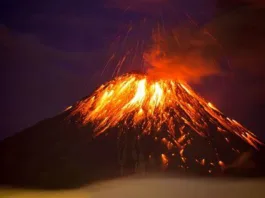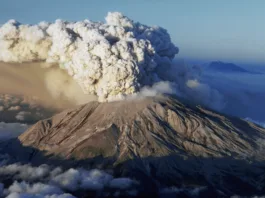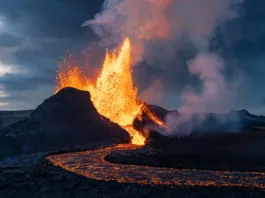Volcán de Fuego, also known as the “Volcano of Fire,” is a highly active and renowned stratovolcano located in Central America. Situated in Guatemala, this volcano has a long history of eruptions, making it one of the most dangerous and closely monitored volcanoes in the region. Its name aptly describes the frequent explosive eruptions that often result in lava flows and pyroclastic flows, creating a stunning yet hazardous natural spectacle.

Volcán de Fuego is famous for its frequent eruptions, which have been documented for centuries. The volcano is part of the Pacific Ring of Fire, an area known for its intense tectonic activity and numerous active volcanoes. Its continuous activity and proximity to populated areas have made it a subject of great interest for scientists, geologists, and emergency authorities.
Location and Geological Characteristics
This stratovolcano is located in the western region of Guatemala, within the Central American Volcanic Arc. It forms part of the Sierra Madre mountain range, situated approximately 16 kilometers (10 miles) southwest of Antigua, a UNESCO World Heritage site and a popular tourist destination.
With an elevation of approximately 3,763 meters (12,346 feet) above sea level, Volcán de Fuego stands as an imposing volcanic peak. Like other stratovolcanoes, it is constructed of alternating layers of volcanic material, including lava flows, ash, and pyroclastic debris. This conical shape results from centuries of volcanic activity and the accumulation of various volcanic products.



Contents
Importance of Monitoring Active Volcanoes
The monitoring of active volcanoes, such as Volcán de Fuego, is of paramount importance for numerous reasons:
- Public Safety: By closely monitoring volcanic activity, authorities can detect early signs of potential eruptions, allowing them to issue timely evacuation warnings and safeguard nearby communities from potential hazards.
- Hazard Assessment: Monitoring data helps in assessing the potential risks and hazards posed by the volcano. Understanding the volcano’s behavior and eruption patterns is essential for developing effective emergency response plans.
- Scientific Research: Studying active volcanoes provides valuable insights into volcanic processes and the Earth’s geology. It contributes to our understanding of volcanic behavior, helping scientists predict future eruptions and enhance preparedness.
- Aviation Safety: Volcanic eruptions can produce ash clouds that pose risks to aircraft. Monitoring allows aviation authorities to issue warnings and reroute flights to ensure safe air travel.
- Environmental Impact: Eruptions can have significant environmental consequences, such as disrupting weather patterns, altering landscapes, and affecting ecosystems. Monitoring helps in assessing and mitigating these impacts.
In conclusion, Volcán de Fuego’s fame and notoriety stem from its frequent eruptions and potential hazards. The volcano’s location, geological characteristics, and active nature make it crucial to continuously monitor its activity for public safety, scientific research, hazard assessment, aviation safety, and environmental protection.
Historical Background
Volcán de Fuego has a long and storied volcanic history that dates back thousands of years. Its eruptions have been documented since the Spanish colonial era, and it has remained one of the most active and dangerous volcanoes in Central America.
The exact date of the volcano’s formation is not precisely known, but it is believed to have been active for at least several hundred thousand years. Volcán de Fuego is part of a volcanic complex that also includes the nearby Acatenango volcano. These two volcanoes are often considered twin volcanoes due to their close proximity and shared geological characteristics.
Throughout its history, Volcán de Fuego has exhibited frequent explosive eruptions, characterized by the release of ash, lava flows, and pyroclastic flows. Its eruptions are typically highly explosive and pose significant hazards to nearby communities and the surrounding environment.
Notable Eruptions in the Past
Volcán de Fuego has had numerous notable eruptions throughout history. Some of the most significant eruptions include:
- The Great Eruption of 1581: This eruption was one of the largest and most catastrophic in the volcano’s recorded history. It caused extensive damage to nearby settlements and resulted in significant loss of life.
- The 1717 Eruption: Another major eruption occurred in 1717, causing widespread devastation in the surrounding areas and leading to further loss of life and property.
- The 2018 Eruption: In recent times, one of the most devastating eruptions occurred in June 2018. The volcano spewed a massive column of ash and gas, triggering pyroclastic flows that engulfed nearby villages. This eruption led to the tragic loss of over 190 lives and caused extensive damage to homes and infrastructure.
Impact on Nearby Communities in Previous Eruptions
The frequent eruptions of Volcán de Fuego have had a profound impact on the nearby communities over the years. The volcano’s proximity to densely populated areas has made it particularly hazardous, and its eruptions have led to significant human and economic losses.
The volcanic ash and pyroclastic flows can destroy crops, contaminate water sources, and disrupt transportation and communication networks. Entire villages and settlements have been buried or severely damaged during some of the more catastrophic eruptions.
Communities living in the vicinity of Volcán de Fuego have had to adapt to the ongoing volcanic threats by implementing early warning systems and emergency preparedness plans. Regular monitoring and communication from volcanologists and authorities are crucial to help residents evacuate safely and minimize the impact of future eruptions.
In conclusion, Volcán de Fuego’s historical background is marked by frequent explosive eruptions that have had devastating effects on nearby communities. The volcano’s eruptions have caused loss of life, property damage, and disruption to local livelihoods, making it a constant concern for those living in its shadow.
2018 Eruption

The 2018 eruption of Volcán de Fuego, which occurred on June 3, 2018, was one of the most devastating and deadly eruptions in the volcano’s recent history. The eruption resulted in a significant loss of life and caused extensive damage to nearby communities.
During this eruption, the volcano expelled a massive column of ash and gas into the atmosphere, reaching heights of several kilometers. The eruption triggered fast-moving pyroclastic flows, which are extremely hot and dense mixtures of volcanic ash, rock fragments, and gases. These flows raced down the slopes of the volcano, engulfing everything in their path.
Several villages and settlements near the volcano were directly impacted by the pyroclastic flows. The communities of San Miguel Los Lotes and El Rodeo, located on the southwestern slopes of Volcán de Fuego, suffered the most devastating consequences. These villages were almost completely buried under layers of volcanic debris, leaving little chance for residents to escape.
The 2018 eruption claimed the lives of more than 190 people, injured many others, and led to the displacement of thousands of residents who had to flee from the danger zone. The intense heat of the pyroclastic flows and the high-speed avalanches of volcanic material left little time for evacuation, resulting in a tragic loss of life.
Emergency responders, volunteers, and authorities immediately initiated rescue and relief efforts to assist those affected by the eruption. However, the scale and intensity of the disaster posed significant challenges to the response operations.
The 2018 eruption highlighted the ongoing need for closely monitoring Volcán de Fuego and the importance of implementing effective early warning systems and emergency preparedness plans for nearby communities. It also underscored the hazards associated with living in close proximity to active volcanoes and the necessity of adhering to evacuation protocols during volcanic emergencies.
In the aftermath of the eruption, efforts were made to aid in recovery, rebuild damaged infrastructure, and provide support to those who lost their homes and loved ones. Additionally, the eruption prompted renewed attention to volcanic risk assessment and the importance of public education on volcanic hazards to enhance community resilience in the face of future eruptions.
Recap of the significance of the Volcán de Fuego eruption

The eruption of Volcán de Fuego in 2018 was a highly significant event due to its devastating impact on nearby communities and its demonstration of the hazards associated with living near active volcanoes. Here’s a recap of the eruption’s significance:
- Loss of Life: The 2018 eruption resulted in over 190 fatalities, making it one of the deadliest volcanic events in Guatemala’s recent history. The rapid and intense pyroclastic flows caught many residents off guard, leaving little time for evacuation.
- Destruction of Property and Infrastructure: The volcanic ash, lava flows, and pyroclastic flows caused extensive damage to homes, agricultural land, and infrastructure in nearby villages. Entire communities were buried or severely damaged by the volcanic debris.
- Displacement and Humanitarian Impact: The eruption led to the displacement of thousands of people who had to evacuate from the danger zone. The affected communities faced significant humanitarian challenges, including the need for shelter, food, and medical assistance.
- Emergency Response and Preparedness: The eruption highlighted the importance of effective emergency response and preparedness measures. It exposed the need for better evacuation plans, early warning systems, and community education to reduce the impact of future eruptions.
- Volcanic Risk Assessment: The 2018 eruption prompted renewed attention to volcanic risk assessment in the region. It emphasized the necessity of understanding the potential hazards posed by active volcanoes and developing strategies to minimize the risks to human lives and property.
- Regional and International Cooperation: The eruption demonstrated the importance of regional and international cooperation in monitoring and responding to volcanic events. Collaboration among neighboring countries and international organizations facilitated information sharing and support during the crisis.
- Public Awareness and Education: The eruption raised awareness about the risks of living near active volcanoes and the importance of educating the public about volcanic hazards. It emphasized the need for communities to be well-informed and prepared to respond to volcanic emergencies.
- Scientific Research: The eruption provided valuable data for scientists and researchers studying volcanic processes and hazards. It contributed to a deeper understanding of Volcán de Fuego’s behavior and the potential implications for future eruptions.
In conclusion, the 2018 eruption of Volcán de Fuego had a profound impact on the affected communities and highlighted the importance of monitoring, early warning systems, emergency preparedness, and public education in volcanic regions. The tragedy served as a reminder of the inherent risks of living near active volcanoes and the ongoing need for proactive measures to protect lives and property in volcanic-prone areas.






